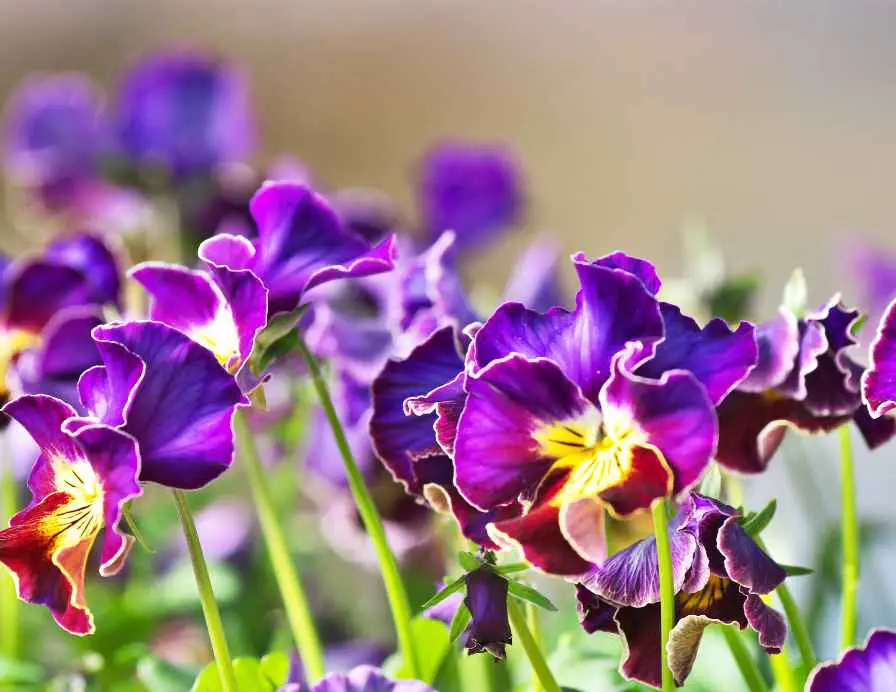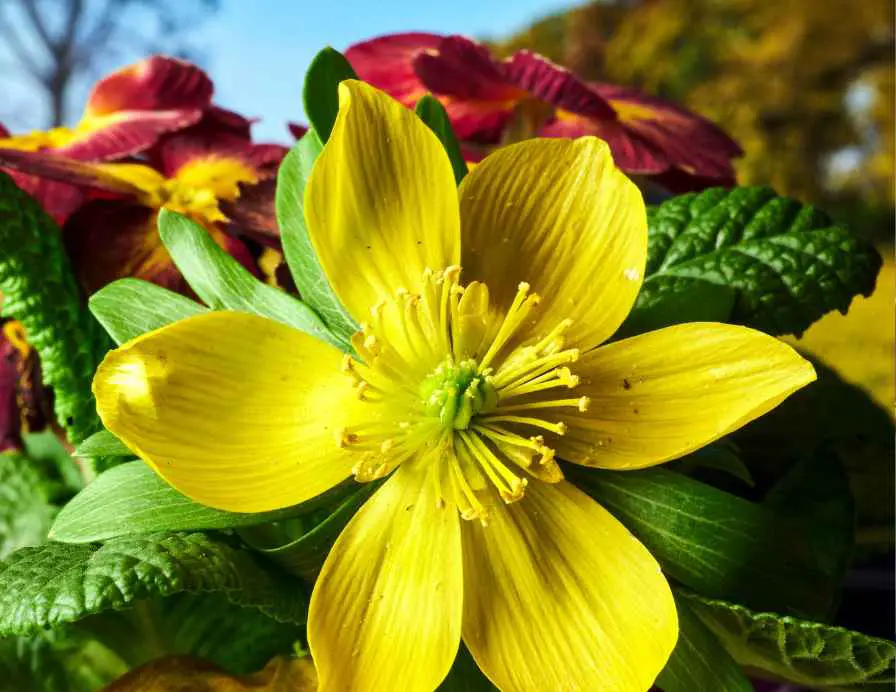Gardeners always want their plants and garden to keep blooming and glowing. But the problem is that the harsh weather conditions don’t always allow that. They often wonder what plants survive in the winter. Well, we are going to tell you that so that you can make your final decision easily.

Plants Surviving in the Winters
Plants have evolved various strategies to survive the harsh conditions of winter. One common adaptation is dormancy, where plants enter a period of reduced metabolic activity. Deciduous trees and shrubs shed their leaves in response to the changing seasons.
By dropping their leaves, these plants minimize water loss and protect themselves from freezing temperatures. They store nutrients in their roots or stems, which they utilize during the dormant period to support new growth when spring arrives.
Evergreen plants, on the other hand, retain their leaves throughout the winter. Their leaves are often covered with a waxy coating that helps to minimize water loss.
Additionally, evergreens have a specialized tissue called cambium that allows them to continue photosynthesis and nutrient transport even during the cold season. This enables them to sustain slow but steady growth and remain green throughout the year.
Some plants have developed unique adaptations to survive in extreme winter conditions. For instance, certain species of plants in alpine regions or high latitudes have the ability to withstand freezing temperatures by producing antifreeze compounds.
These compounds lower the freezing point of their cells, preventing ice crystal formation and damage to the plant’s tissues. Other plants may have specialized structures, such as protective scales or hairy coverings, to insulate their vulnerable parts from freezing temperatures and desiccation.
What Plants Survive In Winter
There are several fruit plants that can survive in winter conditions, particularly those that are adapted to cold climates. Here are some examples of plants known for their hardiness in winter:
Pansies
Pansies are popular winter plants known for their vibrant flowers. They have a strong resistance to cold temperatures and can tolerate frost. Pansies have a low-growth habit that helps them withstand harsh winds and their shallow root systems allow them to quickly absorb water from snow or rain.
Winterberry Holly
This deciduous shrub is native to North America and is well adapted to cold climates. While it loses its leaves in winter, it produces bright red berries that persist through the colder months. Winterberry Holly is known for its tolerance to wet soils and can survive in low-light conditions.
Witch Hazel
Witch Hazel is a small tree or shrub that thrives in winter. It has beautiful, fragrant flowers that bloom even in freezing temperatures. The plant has a unique adaptation called thermogenesis, where it produces heat in its flowers, allowing it to withstand cold weather and attract pollinators.
Snowdrops
Snowdrops are early-flowering bulbs that can be found peeking through the snow in late winter or early spring. They have a hardy nature and can tolerate freezing temperatures. Snowdrops often grow in clumps, and their small white flowers provide a delightful sight during the winter months.
Winter Aconite

Another winter-blooming bulb, winter aconite is known for its yellow, cup-shaped flowers. It can tolerate cold temperatures and even survives in partially shaded areas. Winter aconite has a low-growing habit and spreads through underground tubers.
Siberian Cypress
This evergreen coniferous shrub is native to Siberia, making it highly adapted to cold climates. Siberian cypress has dense, scale-like foliage that provides protection against freezing temperatures and strong winds. It can maintain its green color throughout the winter season.
Japanese Andromeda
Japanese Andromeda is an evergreen shrub that can withstand winter conditions. It has leathery, lance-shaped leaves that stay green year-round and produces clusters of bell-shaped flowers in early spring. This plant prefers slightly acidic soil and partial shade.
Hellebores
Hellebores, also known as Lenten roses, are perennial plants that bloom during late winter or early spring. They have attractive, nodding flowers that come in various colors, including white, pink, purple, and green. Hellebores are well adapted to cold climates and can survive freezing temperatures.
Juniper
Junipers are a group of evergreen conifers that are highly resilient to winter conditions. They have needle-like leaves and can vary in size and shape, ranging from ground-covering shrubs to tall trees. Junipers are known for their ability to tolerate drought and cold temperatures.
Red Twig Dogwood
A deciduous shrub that thrives in winter is the Red Twig Dogwood. It loses its leaves during the colder months, revealing vibrant red stems that add color to the winter landscape. This plant is cold-hardy and can tolerate a wide range of soil conditions.
Apple Trees
Apple trees are well-known for their ability to withstand cold temperatures. There are many varieties available, including those specifically bred for colder climates. They typically require a period of winter chill to set fruit successfully.
Pear Trees
Pear trees are also hardy fruit trees that can tolerate winter conditions. Like apple trees, they require a chilling period, but some varieties are better suited for colder climates than others.
Cherry Trees
Certain cherry tree varieties, such as the sour or tart cherry (Prunus cerasus), are more cold-hardy than others. They can endure freezing temperatures and still produce fruit.
Plum Trees
Plum trees come in various species and cultivars, some of which are adapted to colder climates. European plums (Prunus domestica) and certain Japanese plums (Prunus salicina) are known to tolerate winter conditions well.
Raspberry Bushes
Raspberry bushes are known for their ability to survive cold winters. They are typically deciduous and require a period of dormancy during winter. Proper pruning and winter protection can help improve their chances of survival.
Blackberry Bushes
Blackberry bushes, similar to raspberries, can endure winter conditions. Some cultivars, like the thornless varieties, are particularly popular and cold-hardy.
Currant Bushes
Currant bushes, including black currants (Ribes nigrum) and red currants (Ribes rubrum), are known for their ability to withstand cold temperatures. They are often grown in colder regions for their tart berries.
Elderberry Bushes
Elderberry bushes are native to many regions and are adapted to cold climates. They can tolerate freezing temperatures and produce clusters of small, dark berries.
Blueberry Bushes
Certain varieties of blueberry bushes, such as the northern highbush blueberry (Vaccinium corymbosum) and the lowbush blueberry (Vaccinium angustifolium), can survive in colder regions with proper winter care.
Rosemary
Rosemary is an evergreen herb with needle-like leaves and a distinct fragrance. It is native to the Mediterranean region but can tolerate cold winters if provided with some protection. It thrives in well-draining soil and requires full sun exposure. In colder regions, it is best to grow rosemary in containers.
Thyme
Thyme is a hardy herb that comes in various species and cultivars. creeping thyme (Thymus serpyllum) and Common thyme (Thymus vulgaris) are popular options. It is a perennial herb that can withstand cold temperatures and even frost.
Sage
Sage is a woody perennial herb known for its aromatic leaves. It is native to the Mediterranean region and can tolerate winter conditions well. Sage can tolerate little shade but does best in full sun and well-drained soil.
When cultivating fruit plants in winter-prone areas, it’s essential to consider factors such as hardiness zones, soil conditions, and the specific requirements of each plant variety.
Providing adequate protection during harsh weather, such as mulching the base of plants or using protective coverings, can also help improve their chances of survival. It’s advisable to consult local gardening resources or nurseries for recommendations on specific varieties suitable for your region’s winter conditions.
FAQs
What plants grow in cold climates?
There are many plants that can grow and survive in the cooler climate. Some of these are snowdrops, rosemary, etc.
What plants are best in winter?
There are many plants that do best in the winter. You can go for any of these. Some of these are pansies. Winter aconites, snowdrops, etc.

